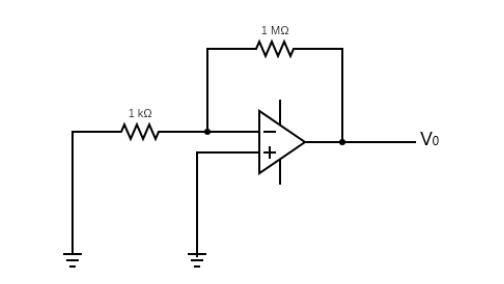
An op amp has an offset voltage of 1mV and is ideal in all other respects. If this op amp is used in the circuit shown in figure the output voltage would be:

(A) 1 mV
(B) 1 V
(C) \[0.1{\text{V}}\]
(D) 0 V.
Answer
218.4k+ views
Hint: In such a circuit, the offset voltage (also known as the input offset voltage) is the input voltage to the op amp. The ratio of the output voltage to the input voltage is equal to the ratio of the resistance across the op amp and the input resistance of the op amp
Formula used: In this solution we will be using the following formulae;
\[{V_{out}} = \dfrac{{{R_F}}}{{{R_{in}}}}{V_{off}}\] where \[{V_{out}}\] is the output voltage of the op amp, \[{R_F}\] is the resistance connected across the op amp, \[{R_{in}}\] is the input resistance usually connected to the negative part terminal of the op amp, and \[{V_{off}}\] is the offset voltage.
Complete Step-by-Step solution:
To solve the above question, as told, we note that the op amp is ideal. This means that for such a circuit the offset voltage would be amplified. This offset voltage is a parameter of an amplifier which gives information about the required input voltage for the operation of the amplifier.
Generally, the ratio of the output voltage to the input voltage is equal to the ratio of the resistance across the op amp and the input resistance of the op amp
\[{V_{out}} = \dfrac{{{R_F}}}{{{R_{in}}}}{V_{off}}\] where \[{V_{out}}\] is the output voltage of the op amp, \[{R_F}\] is the resistance connected across the op amp, \[{R_{in}}\] is the input resistance usually connected to the negative part terminal of the op amp, and \[{V_{off}}\] is the offset voltage.
By inserting known values, we have
\[{V_{out}} = \dfrac{{1000k\Omega }}{{1k\Omega }}0.001{\text{V}} = 1{\text{V}}\]
Hence, the correct option is B.
Note: As seen from the diagram, there is no input signal in the system as both the negative and positive are grounded. Hence, why the offset voltage is used as the input. Also, this is ideal, an non-ideal op amp may give a zero volt at output even at a non zero offset voltage.
Formula used: In this solution we will be using the following formulae;
\[{V_{out}} = \dfrac{{{R_F}}}{{{R_{in}}}}{V_{off}}\] where \[{V_{out}}\] is the output voltage of the op amp, \[{R_F}\] is the resistance connected across the op amp, \[{R_{in}}\] is the input resistance usually connected to the negative part terminal of the op amp, and \[{V_{off}}\] is the offset voltage.
Complete Step-by-Step solution:
To solve the above question, as told, we note that the op amp is ideal. This means that for such a circuit the offset voltage would be amplified. This offset voltage is a parameter of an amplifier which gives information about the required input voltage for the operation of the amplifier.
Generally, the ratio of the output voltage to the input voltage is equal to the ratio of the resistance across the op amp and the input resistance of the op amp
\[{V_{out}} = \dfrac{{{R_F}}}{{{R_{in}}}}{V_{off}}\] where \[{V_{out}}\] is the output voltage of the op amp, \[{R_F}\] is the resistance connected across the op amp, \[{R_{in}}\] is the input resistance usually connected to the negative part terminal of the op amp, and \[{V_{off}}\] is the offset voltage.
By inserting known values, we have
\[{V_{out}} = \dfrac{{1000k\Omega }}{{1k\Omega }}0.001{\text{V}} = 1{\text{V}}\]
Hence, the correct option is B.
Note: As seen from the diagram, there is no input signal in the system as both the negative and positive are grounded. Hence, why the offset voltage is used as the input. Also, this is ideal, an non-ideal op amp may give a zero volt at output even at a non zero offset voltage.
Recently Updated Pages
Young’s Double Slit Experiment Derivation Explained

Wheatstone Bridge Explained: Working, Formula & Uses

Chemical Properties of Hydrogen - Important Concepts for JEE Exam Preparation

JEE General Topics in Chemistry Important Concepts and Tips

JEE Atomic Structure and Chemical Bonding important Concepts and Tips

JEE Amino Acids and Peptides Important Concepts and Tips for Exam Preparation

Trending doubts
JEE Main 2026: Application Form Open, Exam Dates, Syllabus, Eligibility & Question Papers

Derivation of Equation of Trajectory Explained for Students

Hybridisation in Chemistry – Concept, Types & Applications

Understanding the Angle of Deviation in a Prism

Understanding Collisions: Types and Examples for Students

Understanding Atomic Structure for Beginners

Other Pages
JEE Advanced Marks vs Ranks 2025: Understanding Category-wise Qualifying Marks and Previous Year Cut-offs

How to Convert a Galvanometer into an Ammeter or Voltmeter

Understanding Centrifugal Force in Physics

Ideal and Non-Ideal Solutions Explained for Class 12 Chemistry

Degree of Dissociation: Meaning, Formula, Calculation & Uses

Understanding Electromagnetic Waves and Their Importance




